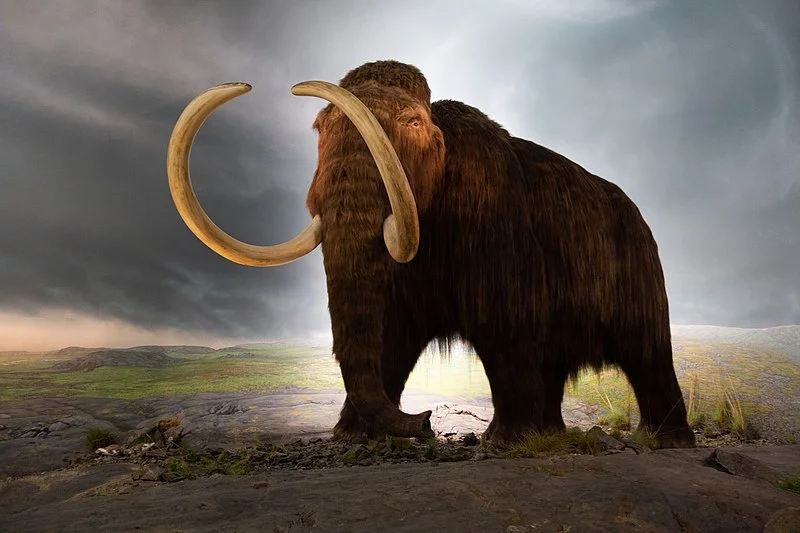prehistoric elephants
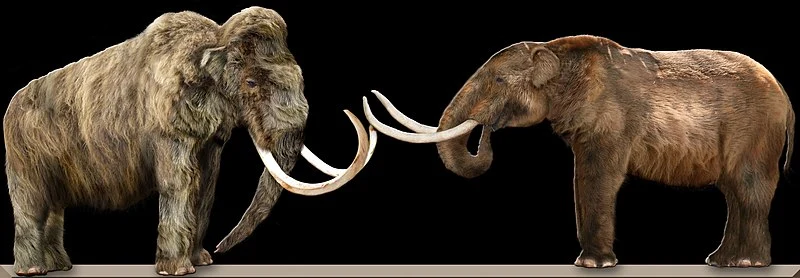
WOOLLY MAMMOTHS
The Woolly Mammoth (Mammuthus primigenius) was a species of mammoth that lived during the Pleistocene epoch, which spanned from approximately 2.6 million to 11,700 years ago. These magnificent creatures were part of the Elephantidae family and shared a common ancestor with modern-day elephants. While Woolly Mammoths were among the most well-known and widespread species of mammoths, there were other species, such as the Columbian Mammoth (Mammuthus columbi) in North America and the Steppe Mammoth (Mammuthus trogontherii) in Eurasia.
Physical Characteristics:
In addition to their impressive size, Woolly Mammoths possessed several distinct physical features that enabled them to survive in cold climates. Their most notable characteristic was their long, curved tusks, which were composed of ivory—a dense, durable material. These tusks were used for various purposes, including foraging for food, digging through snow and ice, and defense against predators or rivals. While both males and females had tusks, those of males tended to be larger and more robust.
The Woolly Mammoth’s body was covered in a thick coat of fur, which provided insulation against the cold temperatures of their environment. This fur consisted of two layers: an outer layer of long, coarse guard hairs and an undercoat of fine, woolly hair. This combination of fur helped to trap heat close to the body, keeping the mammoths warm in freezing conditions. The color of their fur varied, ranging from dark brown to almost black, with some individuals exhibiting lighter patches or markings.



In terms of size, Woolly Mammoths were indeed impressive. While exact measurements varied among individuals and populations, they typically stood between 9 to 11 feet tall at the shoulder, with some reaching heights of up to 13 feet. Their weight ranged from 4 to 6 tons, making them comparable in size to modern African elephants. Despite their massive bulk, Woolly Mammoths were well-adapted to their environment and could move with surprising agility.
Habitat and Distribution:
Woolly Mammoths inhabited a diverse range of environments across the Northern Hemisphere during the Pleistocene epoch. They were particularly well-adapted to cold, subarctic regions, including the mammoth steppe—a vast grassland ecosystem that stretched across northern Eurasia and North America. This habitat consisted of open grasslands, tundra, and shrublands, providing ample grazing opportunities for the mammoths.
In Eurasia, Woolly Mammoths were found across a broad geographical range, from western Europe to eastern Siberia. They were especially abundant in regions such as Siberia and the Russian Far East, where fossil discoveries have been particularly rich. Mammoth fossils have been unearthed from permafrost deposits in these areas, where the cold temperatures helped to preserve the remains over thousands of years.
In North America, Woolly Mammoths roamed across the continent, from the Yukon and Alaska to the Great Plains and the eastern seaboard. They were especially prevalent in regions such as Beringia—a land bridge that connected Asia and North America during periods of lower sea levels. This allowed for the migration of mammoth populations between the two continents, contributing to their widespread distribution.
Diet and Feeding Behavior:
As herbivores, Woolly Mammoths primarily fed on a diet of grasses, sedges, herbs, and shrubs. They used their elongated trunks to grasp vegetation and pull it into their mouths, employing a sweeping motion to strip leaves and grasses from the ground. Woolly Mammoths were well-adapted to grazing in open grasslands and tundra, where vegetation was abundant during the warmer months.
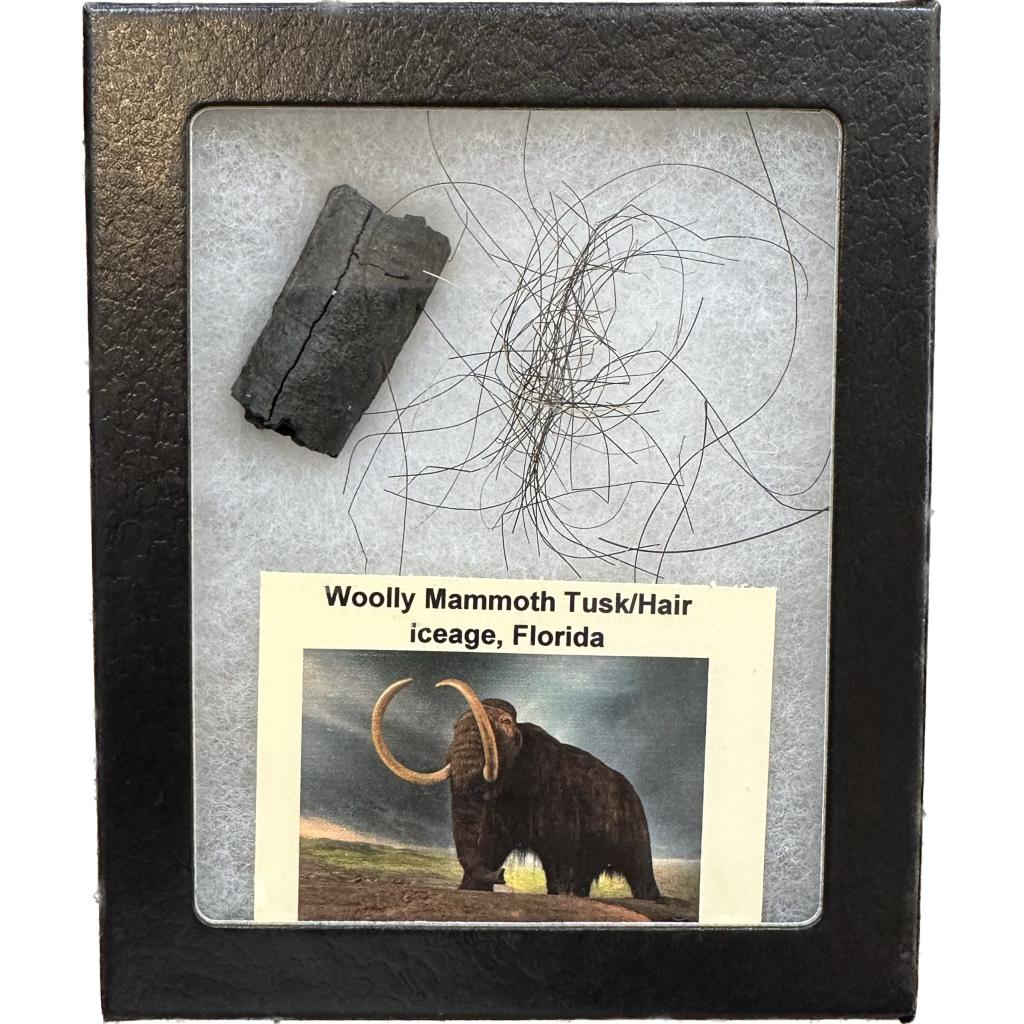
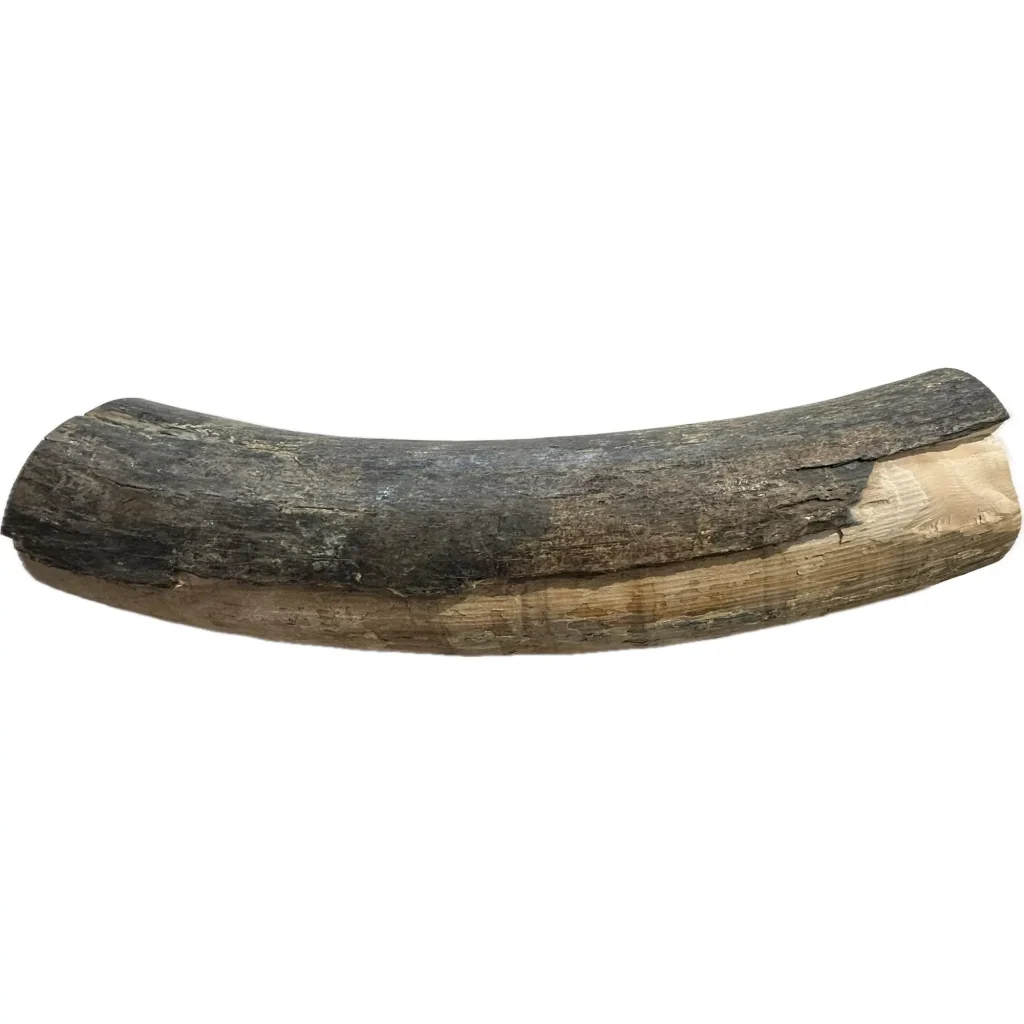
During the harsh winters, when food sources were scarce, Woolly Mammoths relied on their tusks to dig through snow and ice, accessing buried vegetation or frozen plants. They also consumed large quantities of water, obtaining it from freshwater sources such as rivers, lakes, and natural springs. Despite their massive size, Woolly Mammoths had relatively simple digestive systems, similar to modern elephants, which allowed them to efficiently extract nutrients from plant matter.
Extinction:
The extinction of Woolly Mammoths is a subject of ongoing scientific debate, with multiple factors believed to have contributed to their decline. One widely accepted theory is that a combination of climate change and human hunting played a significant role in their extinction. As the Earth’s climate warmed at the end of the last Ice Age, the mammoth’s habitats began to shrink, reducing their food supply and increasing competition for resources.
Human hunting may have also contributed to the decline of Woolly Mammoths. Early humans hunted these massive creatures for their meat, hides, and ivory, which were valuable resources. The arrival of more sophisticated hunting techniques, such as the use of spears and bows, may have further exacerbated their decline. Evidence of mammoth hunting has been found at archaeological sites across Eurasia and North America, indicating the importance of these animals to ancient human populations.
MASTODON
Mastodons, members of the extinct genus Mammut, captivate scientists and enthusiasts alike with their colossal size, specialized diet, and extensive geographical range. In this comprehensive exploration, we delve into the multifaceted aspects of mastodon biology, shedding light on their evolutionary adaptations and ecological roles.
Size and Physical Characteristics:
Mastodons were formidable creatures, towering over their Pleistocene habitats with heights ranging from 8 to 10 feet at the shoulder. Weighing between 4 to 6 metric tons, these massive mammals rivaled modern African elephants in bulk. Their most distinctive feature was their elongated, curved tusks, which could reach lengths of up to 3 meters. These tusks, composed of ivory, served various purposes, including digging for vegetation, stripping bark from trees, and display during social interactions.
In addition to their tusks, mastodons possessed other anatomical adaptations suited to their herbivorous lifestyle. Their teeth were characterized by ridges and cusps, ideal for grinding down fibrous plant material. Unlike their distant relatives, the mammoths, mastodons exhibited a stockier build, with shorter legs and a more robust body structure, reflecting their adaptation to different ecological niches.
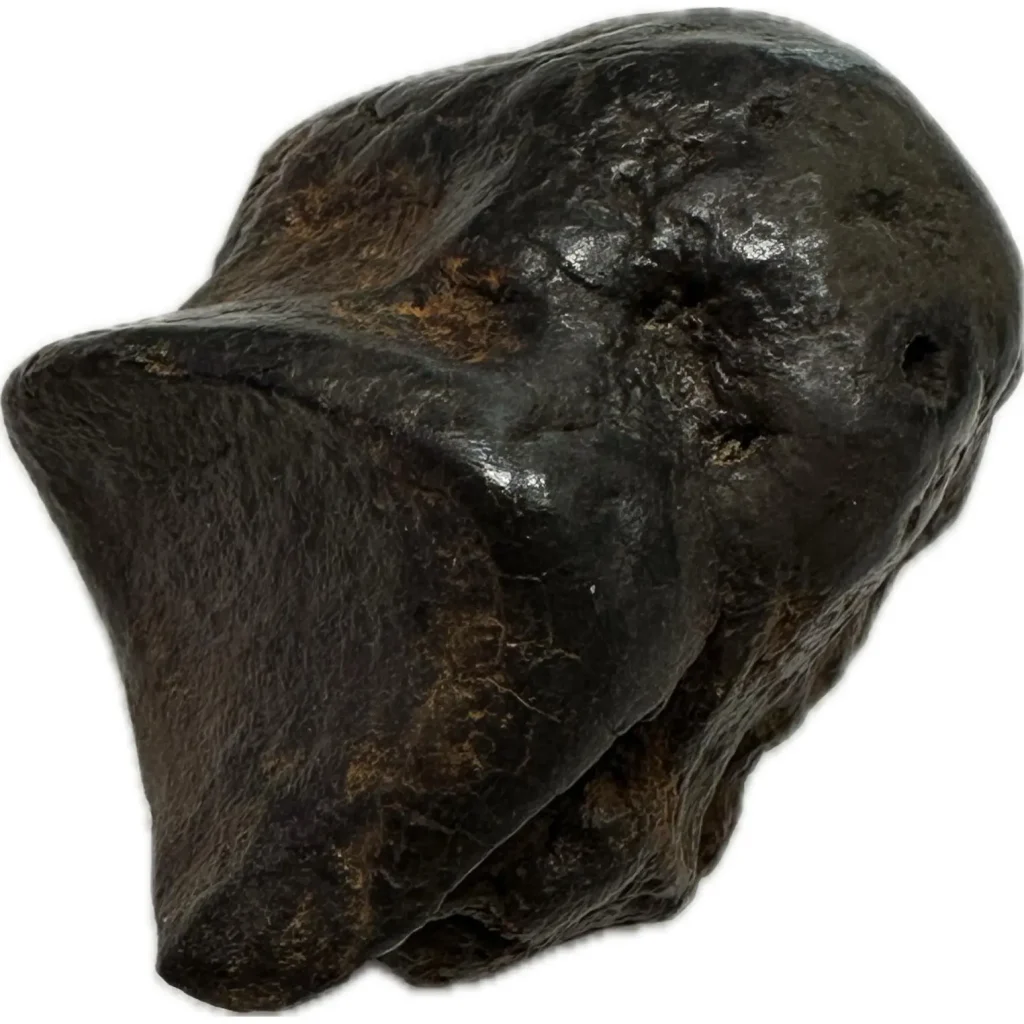
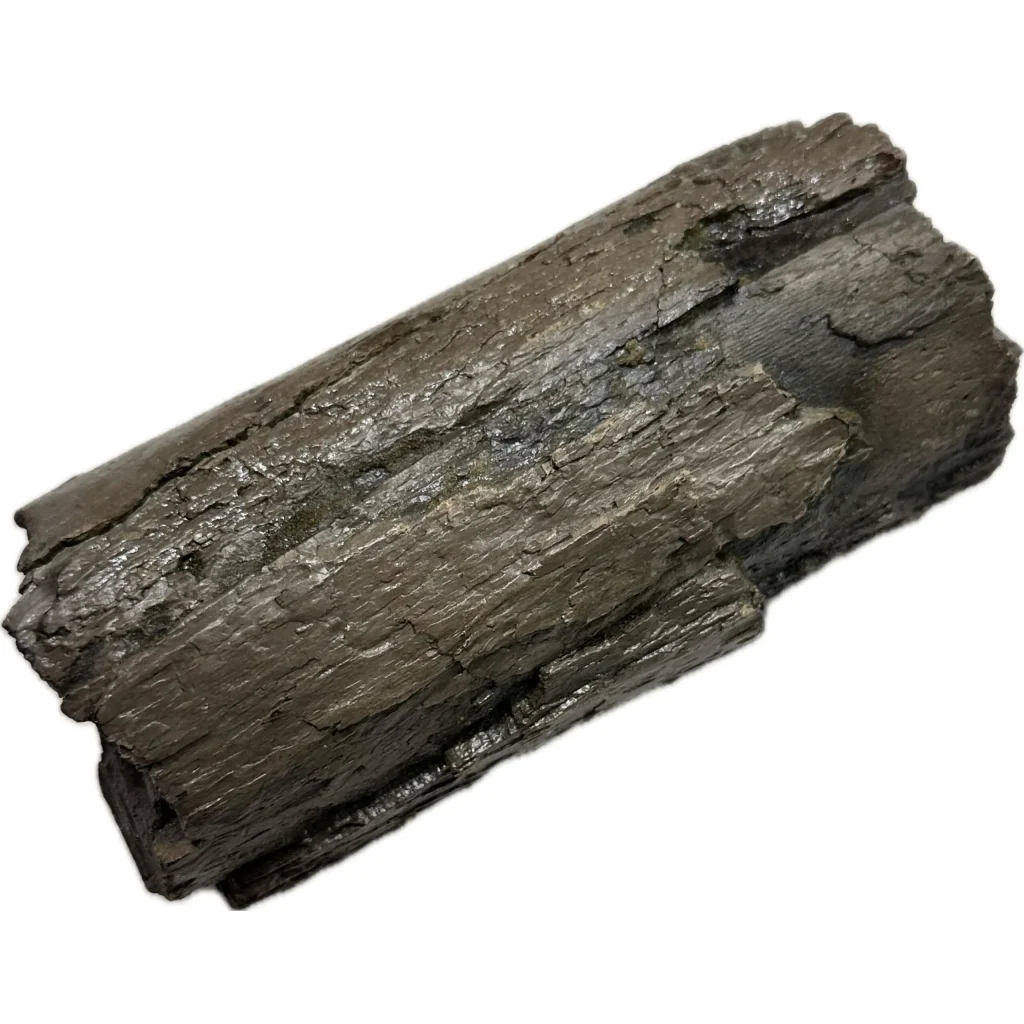

Food Preferences and Diet:
Mastodons were strict herbivores, relying on vegetation for sustenance. Fossilized remains and dental analysis provide insights into their dietary preferences, indicating a reliance on browsing in forested habitats. Unlike modern elephants, which are predominantly grazers, mastodons thrived in wooded environments, consuming a variety of plant matter, including leaves, twigs, shrubs, and fruits.
Their teeth were well-adapted for processing tough vegetation, with enamel ridges designed to shear and grind fibrous plant material efficiently. Seasonal fluctuations in food availability likely influenced mastodon migration patterns, with these creatures moving in search of optimal feeding grounds across diverse landscapes.
Localities and Habitat:
Mastodons occupied a vast geographical range, spanning across North America, Eurasia, and even parts of Africa. Fossil evidence indicates their presence in a variety of habitats, including forests, grasslands, wetlands, and tundra. In North America, mastodons were particularly abundant during the Pleistocene epoch, with fossil discoveries ranging from the Arctic regions of Canada to the southern reaches of Mexico.
Their adaptability allowed them to thrive in different environments, from temperate forests to arid grasslands, showcasing their resilience in the face of changing climates. Mastodons coexisted with a diverse array of megafauna, including mammoths, saber-toothed cats, and giant ground sloths, shaping ancient ecosystems through their interactions and ecological roles.
Evolutionary Significance:
Studying mastodons provides invaluable insights into the evolutionary history of mammals and the processes driving ecological change over geological timescales. Their extinction, along with that of other Pleistocene megafauna, remains a subject of intense scientific inquiry, with hypotheses ranging from climate change to human hunting pressure.
By unraveling the mysteries of mastodons, researchers gain a deeper understanding of Earth’s ancient past and the forces shaping biodiversity through time. These magnificent creatures serve as ambassadors of a bygone era, reminding us of the rich tapestry of life that once roamed the planet.
GOMPOTHERIUM
In the annals of prehistory, amidst the tapestry of extinct megafauna, one creature stands out for its unique blend of size, adaptations, and mystery – the Gompotherium. A member of the Proboscidea order, Gompotheriums roamed the Earth during the Miocene and Pliocene epochs, painting a picture of a bygone era where colossal mammals ruled the land. In this comprehensive exploration, we delve into the fascinating world of Gompotheriums, examining their size, dietary preferences, and the environments they inhabited.
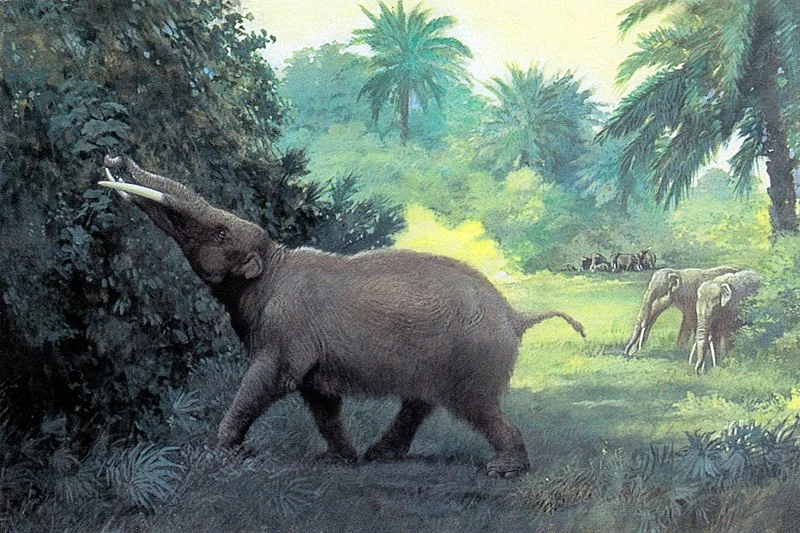
Size and Physical Characteristics:
Gompotheriums were titans of the ancient world, commanding attention with their sheer size and distinctive features. Standing at an impressive height of around 8 to 10 feet (2.4 to 3 meters) at the shoulder, and stretching up to 15 feet (4.6 meters) in length, these behemoths were akin to modern elephants in stature. Their robust bodies were supported by sturdy, pillar-like legs, allowing them to navigate various terrains with relative ease. One of the most striking features of Gompotheriums was their unique dentition – unlike modern elephants, they possessed four tusks, with a pair of large, curved upper tusks resembling those of a shovel, and a smaller set of lower tusks.
Food Preferences and Diet:
An analysis of fossilized teeth and jaw structures provides valuable insights into the dietary preferences of Gompotheriums. These herbivores were primarily browsers, meaning they fed on a diverse array of vegetation found in their habitats. Their well-developed molars were adapted for grinding tough plant material, suggesting a diet consisting of leaves, twigs, fruits, and possibly even aquatic plants in regions where they were available. The presence of shovel-like upper tusks hints at a potential digging behavior, possibly used to uproot vegetation or access buried roots, expanding their dietary options in environments with seasonal scarcity.
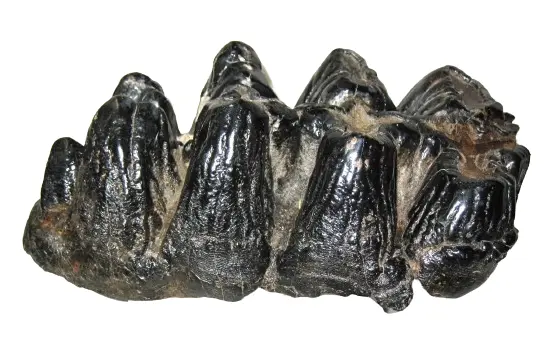
Localities and Habitats:
Gompotheriums were once widespread across various continents, occupying diverse habitats ranging from forested regions to grasslands. Fossil evidence suggests that they roamed through parts of North and South America, as well as Eurasia, during the Miocene and Pliocene epochs. Their fossilized remains have been unearthed in a multitude of locations, including North America (such as Florida, Texas, and California), South America (notably in Argentina), and Eurasia (with findings in Spain and Greece, among others). These findings indicate a remarkable adaptability to different environmental conditions, reflecting their ability to thrive in a range of ecosystems.
BRINGING THE MAMMOTH BACK?
Mammoth cloning stands as one of the most ambitious endeavors in the realm of genetic engineering, promising to revive an extinct species and reshape our understanding of prehistoric life. Embarking on this scientific odyssey involves a blend of cutting-edge technology, ethical considerations, and a deep reverence for Earth’s ancient denizens. In this narrative, we delve into the intricate process of mammoth cloning, exploring its scientific significance, ethical implications, and the potential impact on ecosystems and humanity.
Unveiling the Mammoth:
Mammoths, the colossal creatures that roamed the Earth during the Ice Age, captivate the human imagination with their immense size and shaggy coats. These iconic beasts, belonging to the genus Mammuthus, became extinct around 4,000 years ago, leaving behind only fossilized remains and enigmatic cave paintings. However, recent advances in paleogenomics and genetic engineering have opened a portal to the past, offering a glimpse into the possibility of resurrecting these ancient giants.
Genetic Resurrection:
At the heart of mammoth cloning lies the intricate science of paleogenomics, where fragments of mammoth DNA extracted from well-preserved remains serve as the blueprint for resurrection. Scientists meticulously sequence and analyze these genetic snippets, piecing together the mammoth genome like a cosmic jigsaw puzzle. Through this painstaking process, researchers identify crucial genes responsible for mammoth traits such as shaggy fur, specialized adaptations for cold climates, and the iconic curved tusks.
The Cloning Conundrum:
Cloning a mammoth involves a multi-step process that mirrors the techniques pioneered in the cloning of other animals. One approach involves transferring the reconstructed mammoth genome into the egg cell of a closely related modern species, such as the Asian elephant. Through a series of precise genetic manipulations and laboratory procedures, scientists coax the modified egg cell into developing into a mammoth embryo. This embryo is then implanted into a surrogate elephant mother, who carries the pregnancy to term.
Ethical Dilemmas:
The quest to clone mammoths raises profound ethical questions that resonate with both scientific and philosophical dimensions. Critics argue that tampering with the natural order by resurrecting extinct species may have unforeseen consequences, disrupting ecosystems and biodiversity. Moreover, concerns regarding the welfare of surrogate elephant mothers and the cloned mammoths themselves add layers of complexity to the ethical discourse. Advocates, however, contend that mammoth cloning represents a form of ecological restoration, offering a second chance for a species erased by human activity.
Conservation Implications:
Beyond the realm of scientific curiosity, mammoth cloning holds the potential to catalyze conservation efforts aimed at preserving endangered species and restoring degraded habitats. By resurrecting keystone species like mammoths, scientists hope to engineer resilient ecosystems capable of withstanding environmental challenges such as climate change and habitat loss. Moreover, studying the ecological impact of reintroducing mammoths to their former habitats provides valuable insights into ecosystem dynamics and conservation strategies.
Cultural Significance:
The resurrection of mammoths transcends scientific inquiry, resonating with humanity’s collective consciousness and cultural heritage. For millennia, mammoths have inspired awe and wonder, immortalized in myths, legends, and artistic representations. Bringing these majestic creatures back to life symbolizes humanity’s quest to unravel the mysteries of the past and forge a deeper connection with our natural heritage. From paleontologists to indigenous communities, the revival of mammoths sparks dialogue and reflection on our stewardship of the planet and our responsibility to future generations.
Future Horizons:
As the field of genetic engineering continues to evolve, the prospect of mammoth cloning inches closer to reality. Ongoing research endeavors seek to refine cloning techniques, enhance genomic reconstruction, and address ethical concerns surrounding de-extinction efforts. With each breakthrough, the boundaries of possibility expand, offering glimpses of a future where mammoths once again roam the Earth’s tundra landscapes.
